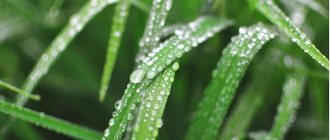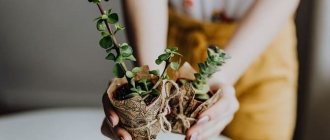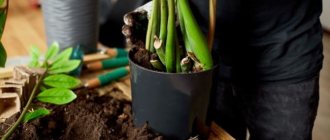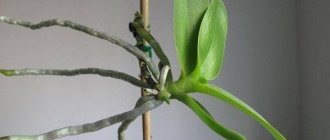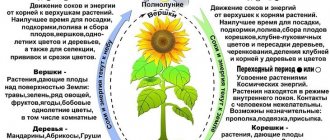Transplanting flowers according to the lunar calendar - general rules
The growth and development of the plant will depend on the phase of the moon during transplantation.
Even in ancient times, it was possible to confirm the impact of the Moon on many organisms living on planet Earth. Flowers that grow both in the wild and at home are considered especially sensitive to phases.
The stage of development of the Moon when transplanting flowers in the future will determine how quickly they will take root and bloom. It is better not to ignore the recommendations of the calendar, since it helps determine the most suitable day for transplanting crops.
The lunar cycle consists of periods:
- new moon;
- growing moon;
- full moon;
- waning moon.
Flower growers are advised not to touch crops on the emerging and full Moon, since during this period all living organisms on Earth are too vulnerable and there is no need to injure them. During planting or transplanting, they most often simply die.
It is possible to establish the phase of the Moon in the following way: it is necessary to substitute a vertical line to the semicircle of the earth's satellite. During the growing phase, the letter “p” is formed, and the sign of the decreasing phase is the letter “c”. Only after determining the phase should a decision be made whether it was worth carrying out a transplant during this period or not.
The influence of moon phases on plants
If you want to work with flowers in accordance with the calendar recommendations, you must be familiar with the relationships between the phases and possible actions.
It is important for amateur flower growers to consider the following phases:
- New moon. During this period, it is not recommended to sow or replant any plants, including indoor flowers.
- Waxing Crescent. This phase has a fairly strong effect on the ground part of the flowers and weakly on their root system. At this time, it is allowed to plant and replant plants that develop above the surface of the earth. In addition, during the waxing moon phase, you can fertilize flowers with mineral elements, water the soil and do vaccinations.
- Full moon. During this period, it is better not to carry out any types of work with flowers. Only plant pruning and grafting are allowed.
- Waning moon. The phase affects the root system of flowers and less actively affects their above-ground part. During this period, it is allowed to plant bulbous plants, carry out fertilizing and pest protection measures.
Planting works best when the moon is waxing. The optimal time for transplantation is considered to be the period when the Moon is in Virgo. Carrying out work at this time has a positive effect on the restoration of the root system and the plant begins to grow quite quickly.
Can you plant plants during the new moon?
Evgeniya
During the day and after the new moon or full moon, no planting work should be done.
Sonya Kobzeva
if it’s on a new moon then yes - according to the calendar
Yarik Alexandrov
it’s possible, but it’s better for a growing one, although if you take three seeds, planted one in a waning moon, one in a new moon and one in a waxing one, then the result is the same
CAT
You can plant the plants. It’s just that the activity of all living things during the new moon is zero.
BE
Only by court decision.
Sergei Kudryashov
Well, if you are not afraid of werewolves, they are activated just on the new moon, then plant them.
Olga
During the new moon and full moon it is better not to work with ratsenias. I don’t do anything at all because I feel very bad at this time
Vladimir Nikolaev
it is forbidden
Evgeniy Gomlyako
No, it’s impossible because the constellation Taurus is in the ass of the constellation Virgo. and especially make sure that the cucumbers grow at a minimum, otherwise there are seven years of failures and all sorts of crap (undergrowth of tomatoes, migraine of potatoes...)
Misha Take a walk
the moon is not my decree
The effect of the full moon on flowers
The Earth's satellite actively influences plant growth
During the full moon phase, the Earth is illuminated to the maximum by the Sun, saturated with its energy. All flowers, and especially the processes of sap flow in the plant, are subject to the influence of the Moon.
When the Moon passes through certain phases, a stretch occurs between the weak and strong gravitational points of the Earth. Water reacts especially vividly to this phenomenon with ebbs and flows.
The gravitational effect of the Moon on the growth of plants is negligible, because their sizes are quite small. It is for this reason that the movement of juices through tissues is not affected by the position of the Earth’s satellite.
However, observations have shown that the Moon still has an energetic rather than a physical effect on the plant. When determining days favorable for planting and transplanting, their bioenergy potential is taken into account.
Studies have shown that flowers react equally to the Earth's satellite both in open and closed ground. The full moon is the phase when their increased activity is noted.
Transplanting plants during the full moon
Many authors of lunar planting calendars say that during the full moon phase it is strictly forbidden to both plant and replant flower crops. The fact is that during this period their roots are too weakened.
There are also recommendations that during the full moon it is not allowed to do any work with indoor flowers. It is better not to plant, transplant, or even trim them.
The creators of other lunar calendars believe that during the full moon it is allowed to plant crops, but they should not be replanted.
Comments (2)
Julia
08/31/2019 at 14:43 |
I rarely pay attention to the lunar calendar when planting plants. Maybe there is something in this, but it is far from the main thing. Astrologers also need to somehow earn a living by building horoscopes and publishing lunar calendars)Answer
Yulia Expert Plodogorod
08/31/2019 at 20:57 |
Hello Julia! You are right, for flower transplantation to go well, you need to take into account a whole range of factors, and not just lunar cycles. For example, it is important that the plant is in good condition and does not look lethargic or sick. After all, changing the soil and pot is still a lot of stress for your pet.
Although, sometimes with fungal and putrefactive lesions of the rhizome, an emergency transplant is required to save the plants. In such cases, the affected parts of the roots are often trimmed down to healthy tissue. In the described situation, when you need to act quickly, we are also not talking about following the lunar calendar.
But, besides this, the Earth’s satellite has a clear and scientifically proven impact on our planet. A striking example is the ebb and flow of tides. This influence, sometimes invisible to us, affects the development cycles of plants. Therefore, if you adhere to the described rules, the likelihood of a successful transplant or other impact on the flower is higher.
Answer
Kind people! When can the seedlings finally be planted? So that she doesn't outgrow)
Polina Shubina
Do the math for yourself. Plant seedlings in a permanent place in the ground: tomato 45-50 days, peppers, leeks, celery -60-65, eggplant -65-70, cucumbers, melons, watermelons - 23. Plus the time from sowing to germination. Worth and count from your disembarkation date.
Igor Kulikov
In the second half of March - peppers, in late March-early April - tomatoes. This is for open ground. Pepper seedlings require 60 days to develop, tomatoes - 45 days from the time of emergence. Planting in open ground in early June. You also need to take into account that seedlings grow rapidly in May. Earlier seedlings will outgrow and form buds, which the plants will most likely shed due to temperature changes in early June when the seedlings are planted. Overgrown seedlings are more difficult to take root and are unable to create biomass for the crop.
Olga Gubanova
Lunar landing calendar for 2009-2010. Everything here is by number, detailed for each month - when it is needed, what can and cannot be planted on a given day.
Svetlana
sowing days of Maria Thun for February 2010
**
Recommendations regarding the timing of the growing season are more correct. You should not blindly trust lunar calendars. About three years ago I became interested in them out of curiosity. I collected 8 calendars from different publications such as Udachka, Garden and Vegetable Garden, Alt. true, Niva, Seasons, : sotok, Sotochka, etc. And I discovered that all the calendars had their own ideas and deadlines, almost all of them did not coincide, and in some of the deadlines they directly contradicted. That is, if in Udachka they wrote that they are unfavorable for tomatoes - 7,8,11,14; March, then in: hundredths - these terms were indicated as the most favorable. I sow seedlings myself according to my grandmother’s instructions. By the moon itself. You cannot sow any plants on the new moon and the last days of the waning moon. The plants will sprout and grow, but they will be weak and painful. I don’t know why, but I was convinced of this from my own experience. So this March, somewhere after March 15, the new Moon will be born (I’ll go out and see when it’s born), and on the 2nd or 3rd day I’ll sow.
Olga
All packets of seeds say at what age to plant seedlings. In the middle zone, frosts can be until June 4. So count from this date and sow
Anna Vodolazskaya
I only plant flowers, I have already sowed petunia, this weekend I want to sow the rest (asters, snapdragons, daisies, etc.).
SlavuskaYa
For February, sowing days for flowers From February 15 to February 28, the waxing moon According to the biodynamic calendar BASIC RULES OF SOWING AND PLANTING BY ZODIAC SIGNS - Fruits, for example, tomatoes, are best planted on the days of Fire (Aries, Leo, Sagittarius). — Leafy vegetables (spinach, onions, lettuce, etc.) are best planted or sowed on Water days (Cancer, Scorpio, Pisces). The same can be said about cauliflower and radish (leafy vegetables planted on the day of Virgo or Sagittarius are especially often arrowed). — When planting root vegetables (celery, carrots, onions, radishes), no one is interested in their beautiful leaves, so it is better to choose the day of Fire (Aries, Leo. Sagittarius), but always with a flawed Moon. Earth days (Virgo, Taurus, Capricorn) serve as an alternative. The exception is Potato: the flawed Moon is beneficial for him, but the sign of Pisces is ideal (especially if it is the third day after the full moon). — Air days (Gemini, Libra, Aquarius) with a young Moon are best suited for planting flowers and medicinal herbs.
February 21-23 - Twins, flower days.
In the M. Thun calendar this is the position of the Moon o. Maria Thun points out that flowers can grow and bloom during sowing and on other days, but how? When sowing on “leaf” days, a lot of greenery is obtained, and the plants have difficulty transitioning to flowering, the plants are too lazy to bloom. If you sow flower seeds during the “fruit” days, they develop very poorly, the leaves are very small, but such plants bloom and ripen very quickly, that is, they immediately proceed to the formation of a seed. If flowering plants are sown during rooting days, they have a very meager above-ground part and also a minimum desire to bloom. But we need them to bloom for a long time and delight our eyes and souls. Maria Thun obtained the most harmonious flowers when sown in Gemini, Libra and Aquarius. The bushes branched well, there were a lot of flower buds, and they bloomed for a very long time and expressed a joyful desire to bloom.
Libra and Aquarius are on the waning moon this month.
Diving is an activity that cannot be performed under the sign of Aquarius. Moreover, it is also advisable to dive when the Moon is waxing. It is better to apply fertilizers during the waning moon.
If you look at the widespread Lunar calendar, there are recommendations mainly for fruit plants. Productive days: Taurus, Cancer, Libra, Scorpio, Pisces. February 19,20 – Taurus February 24,25 – Cancer February 15-16 – Pisces February 17,18 – Capricorn (neutral sign)
Evgenia Taratutina
Everything is learned through personal experience. You will experiment for years and come to the conclusion that it is acceptable for you. But I don’t believe in lunar calendars. And on unfavorable days I plant and get a wonderful harvest.
Irina Kornilova (Sedinkina)
It depends on where you live. In the Urals we are already planting strawberries and peppers. tall tomatoes, celery next. greenhouse tomatoes. And my grandmother used to focus on the Moon - if it’s growing, we plant what ripens above the ground, and if it’s waning, we plant root crops. We do not plant during the new moon or full moon. And so: experience-experience-experience
Surname
Previously, I sowed everything at will, and did not look at the moon. Then I started using the lunar calendar and I can’t say that I started getting crazy harvests. Intuition and the desire to plant today, because you wanted to, leads to good results. For soil I will sow seeds in mid-March.
Tatyana Savchenko SIBERIA
I sow approximately at the following times: eggplants - early February, peppers - mid-February, tomatoes for greenhouses - late February - early March, tomatoes for open ground - late March - early April. I try to plant them in the ground in mid-May-early June, either in a greenhouse or under temporary shelters. BUT!! ! Man proposes, but God disposes. Spring may be late - then they will outgrow. What about lunar calendars... To be honest, they make me smile. I remember reading once that “the favorable day for sowing carrots is May 18th” and that’s it – one single day for the whole spring. Funny? In addition, there is a much more powerful factor than the Moon. This is the Sun. Solar flare - increased solar radiation - accelerated plant growth. And predicting the occurrence of an outbreak is quite difficult.



